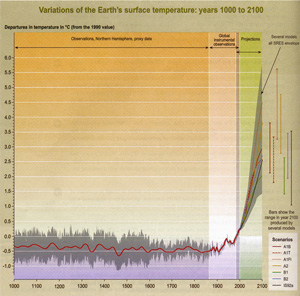| |
Regional and Global Impacts of Climate
Change
|
|
| 9.17 |
Projected climate change will have beneficial
and adverse effects on both environmental and socio-economic systems,
but the larger the changes and the rate of change in climate, the more
the adverse effects predominate.
|
|
9.18
|
Regional changes in climate, particularly
increases in temperature, have already affected and will continue to affect
a diverse set of physical and biological systems in many parts of the
world. Examples of observed changes include shrinkage of glaciers,
reductions in seasonal snow cover, thawing of permafrost, later freezing
and earlier break-up of ice on rivers and lakes, loss of Arctic sea ice,
lengthening of mid- to high-latitude growing seasons, poleward and altitudinal
shifts of plant and animal ranges, changes in the seasonal progression
of some plants and animals, declines in some plant and animal populations,
and damage to coral reefs. These observed rates of change would be expected
to increase in the future represented by any of the SRES scenarios, for
which the warming trends for the 21st century are two to ten times those
observed for the 20th century. Many physical systems are vulnerable to
climate change: For example, the impact of coastal storm surges will be
exacerbated by sea-level rise, and glaciers and permafrost will continue
to retreat. In some mid- to high latitudes, plant productivity (trees
and some agricultural crops) would increase with small increases in temperature.
Plant productivity would decrease in most regions of the world for warming
beyond a few ºC. In most tropical and subtropical regions, yields
are projected to decrease for almost any increase in temperature.
|
 Q3.14 & Q3.18-21
Q3.14 & Q3.18-21 |
| |
Figure 9-1b: Variations
of the Earth's surface temperature: years 1000 to 2100. Over the
period 1000 to 1860, observations are shown of variations in average surface
temperature of the Northern Hemisphere (corresponding data from the Southern
Hemisphere not available) constructed from proxy data (tree rings, corals,
ice cores, and historical records). The line shows the 50-year average,
and the grey region the 95% confidence limit in the annual data. From the
years 1860 to 2000, observations are shown of variations of global and annual
averaged surface temperature from the instrumental record. The line shows
the decadal average. Over the period 2000 to 2100, projections are shown
of globally averaged surface temperature for the six illustrative SRES scenarios
and IS92a as estimated by a model with average climate sensitivity. The
grey region "several models all SRES envelope" shows the range
of results from the full range of 35 SRES scenarios in addition to those
from a range of models with different climate sensitivities.
|
 WGI TAR SPM Figures 1b
& 5d
WGI TAR SPM Figures 1b
& 5d |
| 9.19 |
Ecosystems and species are vulnerable
to climate change and other stresses (as illustrated by observed impacts
of recent regional temperature changes) and some will be irreversibly damaged
or lost. Natural systems at risk include coral reefs and atolls,
mangroves, boreal and tropical forests, polar and alpine ecosystems, prairie
wetlands, and remnant native grasslands. While some species may increase
in abundance or range, climate change will increase existing risks of extinction
of some more vulnerable species and loss of biodiversity. It is well-established
that the geographical extent of the damage or loss, and the number
of systems affected, will increase with the magnitude and
rate of climate change.
|
 Q3.18
Q3.18 |
| 9.20 |
The adverse impacts of climate change
are expected to fall disproportionately upon developing countries and the
poor persons within countries. Projected changes in climate extremes
could have major consequences especially on water and food security and
on health. The vulnerability of human societies and natural systems to climate
extremes is demonstrated by the damage, hardship, and death caused by events
such as droughts, floods, heat waves, avalanches, landslides, and windstorms,
which have shown an increasing trend during recent decades. While overall
precipitation is projected to increase, there are likely to be much larger
changes in intensity and frequency, which will increase the likelihood of
extremes of drying and precipitation, and thus droughts and floods during
the 21st century. These increases combined with increased water stress (occurring
already because of increasing demand) will affect food security and health
especially in many developing countries. Conversely, the frequency and magnitude
of extreme low-temperature events, such as cold spells, is projected to
decrease in the future, with both positive and negative impacts. |
 Q3.17, Q3.21-22,
& Q3.33
Q3.17, Q3.21-22,
& Q3.33 |
